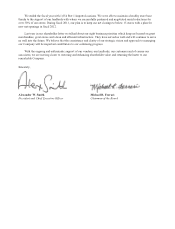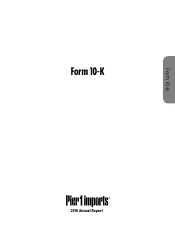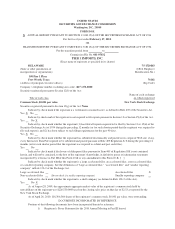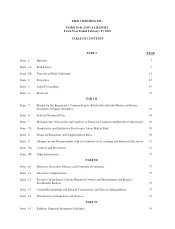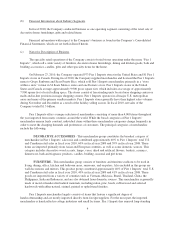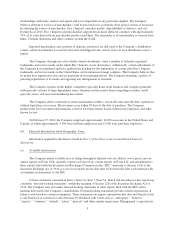Pier 1 2010 Annual Report Download - page 14
Download and view the complete annual report
Please find page 14 of the 2010 Pier 1 annual report below. You can navigate through the pages in the report by either clicking on the pages listed below, or by using the keyword search tool below to find specific information within the annual report.Failure by the Company to identify and successfully implement strategic initiatives could have a negative
impact on the Company.
The Company’s return to profitability and long-term growth are dependant on its ability to identify and
successfully implement strategic initiatives. If these initiatives are not properly developed and successfully
executed, the implementation of such initiatives may negatively impact the Company’s operations. While the
Company believes these disruptions would be short-term, it is unknown whether the impact would be material.
The Company began implementing a strategy during fiscal 2008 for returning the Company to profitability. If the
Company’s turnaround strategy does not continue to be successful, takes longer than currently projected due to
the recession or other factors, or is not executed effectively, the Company’s business operations and financial
results could be adversely affected. In addition, the Company’s inability to develop a successful long-term
strategy could adversely affect the Company’s business operations and financial results.
The Company must be able to anticipate, identify and respond to changing trends and customer
preferences for home furnishings.
The success of the Company’s specialty retail business depends largely upon its ability to predict trends
in home furnishings consistently and to provide merchandise that satisfies consumer demand in a timely manner.
Consumer preferences often change and may not be reasonably predicted. A majority of the Company’s
merchandise is manufactured, purchased and imported from countries around the world and may be ordered well
in advance of the applicable selling season. Extended lead times may make it difficult to respond rapidly to
changes in consumer demand and as a result, the Company may be unable to react quickly and source needed
merchandise. In addition, the Company’s vendors may not have the ability to handle its increased demand for
product. The seasonal nature of the business leads the Company to purchase and requires it to carry a significant
amount of inventory prior to its peak selling season. As a result, the Company may be vulnerable to evolving
home furnishing trends, changes in customer preferences, and pricing shifts, and may misjudge the timing and
selection of merchandise purchases. The Company’s failure to anticipate, predict and respond in a timely manner
to changing home furnishing trends could lead to lower sales and additional discounts and markdowns in an
effort to clear merchandise, which could have a negative impact on merchandise margins and in turn the results
of operations.
Failure to control merchandise returns could negatively impact the business.
The Company has established a provision for estimated merchandise returns based upon historical
experience and other known factors. If actual returns are greater than those projected by management, additional
reductions of revenue could be recorded in the future. Also, to the extent that returned merchandise is damaged,
the Company may not receive full retail value from the resale of the returned merchandise. Introductions of new
merchandise, changes in merchandise mix, merchandise quality issues, changes in consumer confidence, or other
competitive and general economic conditions may cause actual returns to exceed the provision for estimated
merchandise returns. An increase in merchandise returns that exceeds the Company’s current provisions could
negatively impact the business and financial results.
A disruption in the operation of the domestic portion of the Company’s supply chain could impact its
ability to deliver merchandise to its stores and customers, which could impact its sales and results of operations.
The Company maintains regional distribution centers in Maryland, Ohio, Texas, California, Georgia and
Washington. At these distribution centers, merchandise is received, allocated, and shipped to the Company’s
stores. Major catastrophic events such as fire or flooding, malfunction or disruption of the information systems,
or shipping problems could result in distribution delays of merchandise to the Company’s stores and customers.
Such disruptions could have a negative impact on the Company’s sales and results of operations.
8


